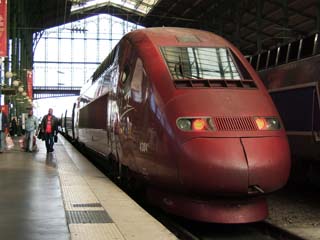 |
The trip to Brussels was a quick trip of a little over
an hour on the "Thalys" high-speed train which leaves through the Gare
du Nord station and passes through the currently ablaze St Denis area
of Paris. We didn't even know there was any trouble and only
stayed in the station for a few seconds before the train left.
|
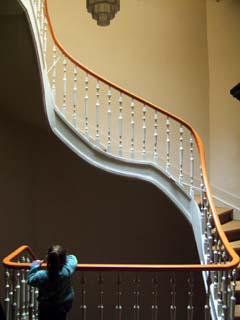
|
We were going to visit
Maïté's cousins who live in Brussels so we got to stay with
them and were treated to an insiders view of the city.
|

|
Brussels is a
relatively small city in a relatively small country but it is the
capital of the European Union and has a good deal of culture of its
own. The country has two distinct parts based on the prevailing
language (French or Flemish). Most people choose to learn only
one
of these two languages so there are two parallel school systems.
Fortunately for me, most also learn English as a sort of neutral
language for communicating between the two.
|
 |
I'm shameless and will
take photographs anywhere, including the local grocer where a pack of
Belgian ale is about 3.50 euros ($4.20). This image is for my
beer-drinking buddies back home. He he he. Belgian
ale is a big favorite of mine but in the US it often costs upwards of
$5.00 a bottle. So
little time.
|
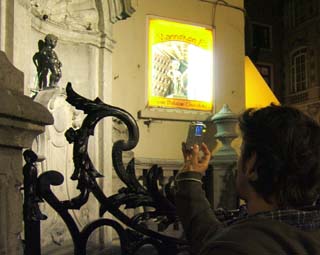 |
This is the famous
"Manneken Pis". The Belgians are a bit confused why this little
fellow is so popular. I had to explain that he has been
reproduced in every possible manner. My dad even had a version
that would dispense a shot of whiskey into your glass. In the
sign to his right, he is advertising that other famous Belgian
commodity:
Chocolates.
|
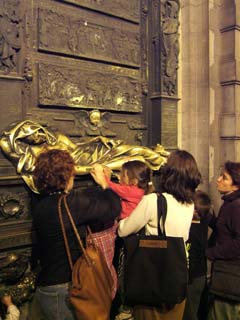
|
A local favorite is
this figure that you are supposed to touch for good luck. It is
several centuries old but seems to be holding up. You gotta love
bronze.
|
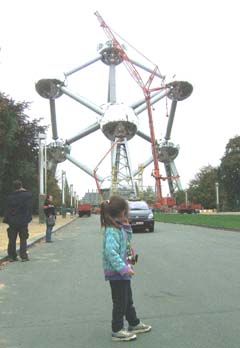 |
The Worlds Fair of
1958 was marked by this piece (by A. Waterkeyn, an engineer), which is
called the "Atomium" and was intended to celebrate the then coming
Atomic age.
|
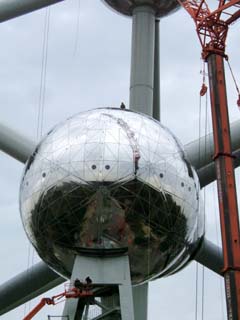
|
They were almost but
not quite done refurbishing the Atomium when we visited so we weren't
able to go up inside. The last time I saw the Atomium it had
faded a bit but the aluminum surfaces are nicely polished now.
Note the tiny images of workers. The Atomium is huge, over 300
feet tall, which makes it one of the tallest structures in Brussels so
it dominates the skyline.
|

|
There was a
retrospective of the work of Belgian sculptor Panamarenko at the Royal
Museum of Fine Arts of Belgium. I wasn't allowed to take pictures
but the web site is (www.expo-panamarenko.be). As I
overheard one Belgian describe his work "he makes flying machine that
cannot possibly fly". It was fun for me as an Aerospace Engineer
to see how he was able to present the ideas of my trade better than
most of the exhibits of machines that can
fly.
|

|
Being admitted
tourists, we went out for "Mussels in Brussels". This drawing of
the event is by almost five-year-old Leila.
|
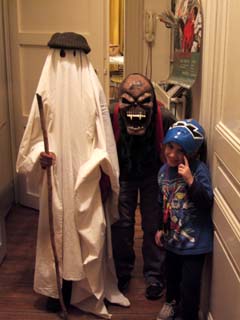 |
We introduced several
of the neighbors to the American celebration of Halloween. Most
were just confused but managed to scrounge up some candy. Some
were not amused at the idea of children begging for candy (my
apprehension at the time was that this might have something to do with
Halloween coming at the end of Ramadan). One woman was caught
off-guard by Aidan's horrible monster mask enough to shriek out loud
followed by three minutes of laughter--probably the best possible gift
to a ten-year-old trick-or-treater.
|
 |
Ours were not
the only ghosts out that night. I caught this one walking in the
street. The kids didn't believe it was a real ghost and checked
the spot to see for sure.
|

|
While Maite and
the kids investigated the local playgrounds, her cousin Nathalie and I
traveled to
the city of Ghent in the Dutch part of Belgium to visit the SMAK
(Stedelijk Museum voor Actuele Kunst). |
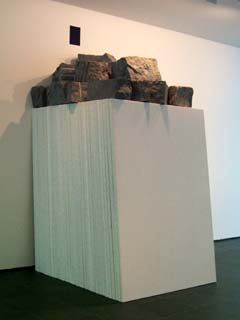 |
There were several
pieces by Italian painter/sculptor Giovanni Anselmo. The
accompanying text revealed that he has been searching for a way to
present images that are free from "referential elements" and present
work that is "frozen in time". Hmm. To me it seemed more
about gravity and the potential energy stored so precariously. He
had several pieces that utilized heavy masses that were intended to
deny motion and therefore any reference to time.
|
 |
This piece by Wim
Delvoye was fun: a cement mixer reproduced in highly ornate carved
mahogany surrounded by shovels bearing the coats of arms of dozens of
families. ( Delvoye is most well known for his piece "Cloaca"
which is a forty foot long machine that models human digestion.
You put food in one end and it creates...well...shit.) I need to
learn more about Delvoye.
|
 |
We went out into Ghent
to find a couple of installations. The city is gorgeous and must
have been doing quite well in the middle ages as well because there is
a whole row of cathedrals on this street.
|
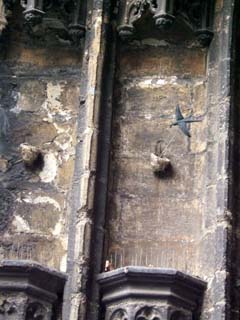 |
Graffiti and street
art in Belgium seemed to me to be of a much higher caliber than that in
France. Here an anonymous artist has installed nests and a model
of a Swallow amidst the otherwise spiked off no-bird-zone of this
cathedral. It makes me wonder if they have "Welcome" mats or "We
want you" signs in front of prisons.
|
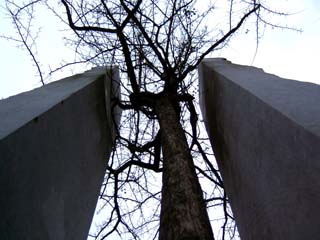 |
Nathalie Joiris is
working with live trees in her sculpture which means her work changes
with time as the tree grows. This image is of one a group of
three installed in a park near a pond. It is composed of four
meter tall "petite granite" slabs and trees which are now taller than
the stones. Nathalie spoke of adjusting the trees as they grow.
|
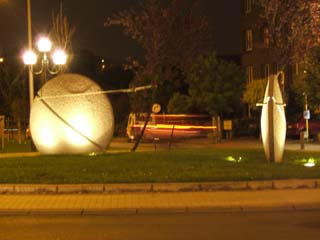 |
We had time to see
another piece of Nathalie's but it was already dark. Here is a
link to better images of her work (
www.nathaliejoiris.com/fr/artpubl03.php ).
|


















